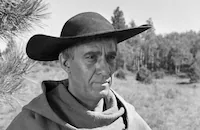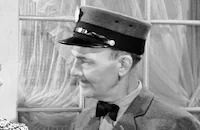Branded
Brief Synopsis
Cast & Crew
Rudolph Maté
Alan Ladd
Mona Freeman
Charles Bickford
Robert Keith
Joseph Calleia
Film Details
Technical Specs

Synopsis
After a fugitive gunfighter known as Choya narrowly escapes capture, he is tracked to his mountain encampment by wandering cowboys Leffingwell and "Tattoo," who have actually followed him across several states. Lef tells Choya that he has a proposition which would net them wealth and a ranch, and in order to assure the plot's success, Tattoo brands a tattoo on Choya's shoulder. When they ride out for supplies, however, Lef shoots Tattoo in the back so that he and Choya will not have to divide their profits three ways. Lef and Choya split up when they arrive at Richard Lavery's Bar M Ranch. Choya asks the foreman, Ransome, for work as a ranchhand, but Ransome refuses to hire the gunfighter, so Choya knocks him down. When Lavery and his daughter Ruth ride up, Ruth sees that Ransome's pride was hurt, and urges him to hire Choya because they need more ranchhands. Later that night, Choya encounters Ruth in the courtyard, and she tells him about her long-lost brother who was kidnapped when he was five years old. Although her father offered a $100,000 reward, the boy was never seen again. Ruth is friendly toward Choya, but Lavery comes along and warns Choya to stay in his place. The next day, Choya overhears the ranchhands talking about the fact that Lavery does not like anyone but him to break a horse. Without hesitation, Choya jumps into the ring and rides a new horse to break it. An angry Lavery sees him and tells him to get off the ranch. When Choya responds insolently, the two get into a fistfight, but Lavery stops suddenly when he sees the tattoo on Choya's shoulder, which matches his lost son's birthmark. When Lavery learns that Choya has no family, he believes that he may be his son. Choya denies the possibility, and maintains an attitude of disinterest, following the plan that he and Lef have devised, so that he can inherit the ranch. When Lavery presents Choya to his wife, Choya pretends to recall a childhood rocking-horse with a missing front leg, information given to him by Lef, and the Laverys believe that he is indeed their son. Choya is now warmly welcomed into the family as Richard, Jr., but becomes uncomfortable with the responsibility of lying to them. Just as he is about to tell Lavery the truth, Lef reappears and is hired as a ranchhand. Choya prevents Lef from killing Lavery so that he can obtain the inheritance immediately, and insists that they take only the money they will get from selling the cattle, and then disappear. Choya heads the cattle drive, and Ruth rides along. When they arrive in El Paso, Choya has a change of heart and deposits the check into the Lavery bank account. When a friendly sheriff tells Choya he initially tracked the kidnappers all the way to New Orleans, Lef's former home, Choya realizes that Lef was the kidnapper. In a hotel room, Choya plays Russian roulette with Lef until he confesses that after kidnapping the boy, he lost him to notorious Mexican bandit Mateo Rubriz, who adopted him as his own son. Choya warns Lef to stay away from the Laverys, then tells Ruth the truth about himself and leaves. Ruth returns home with the bad news, and for his wife's sake, Lavery vows to find Choya and force him to live as their son. Choya, meanwhile, has found their real son, who has been living as Rubriz' son Tonio and is shocked to learn of his true heritage. However, Lef arrives shortly after and Rubriz takes Choya hostage. Although Tonio is devoted to his father, he frees Choya, who kidnaps him. Tonio is wounded during their escape, and Rubriz goes out with his gang to recover him. The fugitives narrowly escape capture, and Tonio agrees to go willingly when he is convinced of Choya's good intentions. That night, they steal two horses from Rubriz's camp and escape, and Lef is killed in a stampede while trying to stop them. Tonio helps Choya outwit the gang at the Rio Grande River, but he and Choya collapse on the other side, and are rescued by Lavery and Ransome. Rubriz tracks them to the ranch and holds Choya hostage as Tonio recuperates in bed. After several tense minutes, Choya convinces Rubriz that Tonio is still loyal to his adoptive father, and Rubriz calls off his gang. The Laverys are reunited with their son, agreeing that he will see Rubriz as he pleases. Choya tries to slip away unnoticed, but Ruth follows him and pledges her love.

Director
Rudolph Maté
Cast

Alan Ladd

Mona Freeman

Charles Bickford

Robert Keith

Joseph Calleia
Peter Hansen

Selena Royle

Tom Tully
John Berkes

Milburn Stone

Martin Garralaga
Edward Clark

John Butler
George Lewis
Robert Kortman
Pat Lane
Pepito Perez
Russ Saunders
Natividad Vacio
Carlos Conde
Ralph Gomez
Felipe Turich
Joe Dominguez
Guy Zanett
Julia Montoya
Jimmie Dundee
Salvador Báguez
Frank Mccarroll
Ed Peil
Olan Soule
Sam Finn
Richard Botiller
Carl Andre
Jerry James
Jack Roberts
James Cornell
Len Hendry
Crew
Glen Alden
Roland Anderson
Claire Behnke
Guy Bennett
Sydney Boehm
Frederick Hazlitt Brennan
Hugh Brown
Monroe W. Burbank
Frank Caffey
Art Camp
Harry Caplan
Gladys Carley
C. C. Coleman
William H. Coleman
Sam Comer
John Coonan
John Cope
Ray Cossar
Ray Cossar
Ed Crowder
Bill Cunningham
Hans Dreier
Pat Drew
Andy Durkus
Phil Eastman
Don English
Mel Epstein
Ed Fitzharris
John Hamilton
Doane Harrison
James Hawley
Edith Head
Earl Hedrick
Hazel Hegarty
Harry Hogan
Cyril Hume
Bill Hurley
Richard Johnston
Wallace Kelley
Julian Kilson
Charles B. Lang Jr.
Sam Levine
Harry Lindgren
Alma Macrorie
Nellie Manley
Robert Mccrellis
Bert Mckay
Walter Mcleod
Kenneth Meade
James Miller
Winston Miller
Ray Moyer
Bob Rogers
Ernesto Romero
Oscar Rudolph
Edward Salven
Tommy Summers
Herb Tice
Paul Uhl
James Vincent
Lenore Weaver
Roy Webb
Wally Westmore
Willard Willingham
William Woods

Film Details
Technical Specs

Articles
Branded
The story concerns a gunfighter named Choya (Alan Ladd), hunted by posses and trusting of no one. He is such a loner that when someone asks him early on if he has any friends, he replies, "My guns." Any kinfolk? "My horse." He is even named for the Spanish word for cactus - when asked why, he answers soberly, "Ever try to pick one up?" Managing to approach this glum and scary fellow is the weasally T. Jefferson Leffingwell (an outstanding Robert Keith), who is proposing a get-rich-quick scheme. It seems that years ago, the son of a wealthy ranch owner was abducted and taken across the Rio Grande, where he grew up under the eye of a notorious Mexican bandit/landowner. His parents never knew this, however, and they searched for the boy to no avail. The boy had a distinguishing birthmark on his shoulder, and Leffingwell happens to know what it looks like. All Choya has to do is agree to be tattoed with an identical mark, memorize a few salient facts about the boy, and let himself be "found" by the family and taken in as their long-lost son. The only thing that will then stand in the way of an inheritance is a lethal "accident" to the ranch owner.
Choya goes along with the plan, but his heart starts to soften from the kindliness of his new family (led by the always-reliable Charles Bickford as the father, and featuring pretty Mona Freeman as a daughter). Ladd makes this change believable and sympathetic, and to its credit the movie does a good job of not presenting it mawkishly. When Ladd decides what new action to take, he does it with a straightforward conviction that makes it enjoyable to root for him. Ladd had not made many westerns by this point in his career, and Shane was still three years away. He inhabits the gunfighter's role extremely well, however, and uses much of his steely persona from classic noirs like This Gun For Hire (1942) and The Glass Key (1942). Branded even works in a startling scene in which Ladd uses Russian roulette to get some information out of a character, and you believe he would let the bullet fly.
But the best thing going for Branded is that it is simply a sight to behold. Photographed in Technicolor in the mountains of Arizona and Utah, the movie is never less than stunning visually, with breathtaking clarity and beauty from one frame to the next. The colors of the mountains, costumes and sets are vivid, and the movie has a crispness of pace which prevents it from being just a series of pretty pictures. Considering this is the work of cameraman-turned-director Rudolph Mate, it's no surprise really.
This, after all, was the man who shot The Passion of Joan of Arc (1928), Vampyr (1932), Stella Dallas (1937), That Hamilton Woman (1941), Cover Girl (1944), and Gilda (1946) - all famously beautiful pictures. The Polish-born Mate received five Oscar® nominations in five straight years for his cinematography, though he never won the award. He turned to directing in 1947, and his best films were probably The Dark Past (1948), D.O.A. (1950), Branded, When Worlds Collide (1951), and The Violent Men (1955). While his films as director were not always successful, they did always look great.
Branded could use a bit of restoration - there are several brief light leaks scattered through the movie on the left side of the frame. But this is actually a minor distraction, as the color overall has held up nicely. Paramount's DVD is a no-frills affair - just the movie and an appealingly low price. It's well worth it.
For more information about Branded, visit Paramount Home Entertainment. To order Branded, go to TCM Shopping.
by Jeremy Arnold

Branded
Quotes
Trivia
Notes
The working title of this film was Montana Rides. In studio production files in the Paramount Collection at the AMPAS Library, supervising editor Doane Harrison was also listed as co-director on the film. Harrison was supervising editor on all of director Billy Wilder's films and was frequently listed in production notes as co-director. Wilder has stated in a modern interview that while the credit should not be interpreted as equal to the director, he considered Harrison a highly-esteemed collaborator. Harrison was present on the set of Wilder's films, adding his input on the concept of the scenes, and recommending certain shots. It is likely that Harrison contributed in this manner to Branded.
According to Hollywood Reporter news items, Leslie Fenton was originally scheduled to direct the film. Although a March 1, 1950 Hollywood Reporter news item lists Gile Steele as co-costume designer with Edith Head, Steele was not credited onscreen, or in production files, and his contribution to the final film has not been confirmed. Peter Hansen made his feature film debut in the picture. Hollywood Reporter news items add Byron Hightower, Carl Sepulveda, Henry Wills and Roque Ybarra to the cast, but their appearance in the final film has not been confirmed. According to production files, location shooting took place in Douglas, Portal, San Simon and Globe, AZ. Scenes of the Salt River Canyon were shot near Globe. Some scenes were also shot at Vasquez Rocks in Chatsworth, CA, and the Monogram Ranch in Placerita Canyon, Newhall, CA. Burt Lancaster and Charles Bickford appeared in a Lux Radio Theatre version of the story, broadcast on January 28, 1952.














